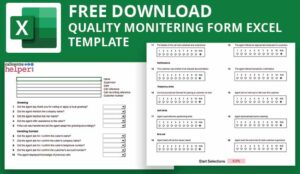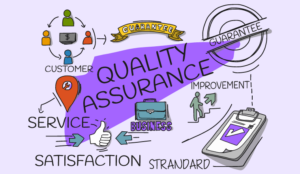Do you know how well your agents are handling every customer interaction?
Does their performance meet your expectations for a quality customer experience?
Are they following all the correct processes, remaining compliant, and getting the outcomes you want?
The only way to answer all these questions is with a call monitoring form.
What is a Call Monitoring Form?
A call monitoring form is an evaluation system that scores your agents based on how well or poorly they handled the customer interaction based on preset criteria. It’s an invaluable tool for enhancing transparency within your contact centre and ensuring consistent, high-quality customer service.
Typically not included in your call centre monitoring software, call centre QA forms provide essential feedback that you can’t get any other way.
They can be used to train and motivate your agents, identify trends within the contact centre, reveal skills, areas, and processes that are lacking, and promote high-scoring agents.
When used correctly, call monitoring forms help you improve your overall contact centre performance, resulting in higher customer satisfaction (CSAT) and Net Promoter Scores (NPS).
Using Call Centre QA Forms for Scoring and Training
The key to successfully using call centre QA forms is customizability. They should be completely customizable to your agent needs, communication channels, training, and best practices.
For example, the types of processes you’ll evaluate in a live chat are different than those you’ll evaluate for a telephone call, which is why a scorecard template is a bad idea.
You need a call monitoring form that only includes the elements you find most essential to your success.
That’s why it’s essential that you engage your call centre agents at all levels of the QA process. Your agents should be there to help you come up with what’s needed on you call centre QA form from the beginning.
Then, as you’re iterating, changing, and responding to customer needs, your agents should be involved in continually re-crafting the QA framework.
This will get them highly involved in the QA process and encourage their engagement. It will also ensure that your call monitoring form matches your needs.
What Should Be Included on Your Call Monitoring Form?
The focus of your call centre QA form depends on your business priorities and the sector that you work in. At the same time, there are various opinions about what constitutes a good customer experience depending on the channel that the customer uses to contact you, so that may also impact what appears on your call monitoring form.
That’s why it’s so important to be able to create call centre quality assurance evaluation form samples based on how you’re communicating with the customer.
However, in the interest of simplification, there are four essential areas that should be included on your call monitoring form—no matter the channel:
- Soft Skills
- Process
- Compliance
- Outcomes
Soft Skills
Agent soft skills are a critical predictor of call centre agent performance. Without people skills that allow your agents to effectively interact with customers, supervisors, and coworkers, they will not be able to successfully deliver a quality customer experience.
In particular, you need to be able to test an agent’s communication skills, professionalism, ability to gain the trust of his/her customers, product knowledge, and problem-solving.
Some call monitoring form sample questions, include:
- Did the agent display active listening skills?
- Did the agent build rapport and show understanding of the client?
- Was the agent’s tone and pitch appropriate to the mood of the call?
- Did the agent summarize the follow-up plan?
- Was the agent professional at all times?
Process
In most organizations, the customer service process is very important. Your call monitoring form should have a way to help you determine if the agent followed all the correct processes. The exact processes you decide to include on your form can vary, but examples include
- Did the agent follow the correct process?
- Did the agent follow the compensation process?
- Did the agent terminate the call correctly?
- Did the agent update the notes in the CRM case?
Compliance
There are also compliance areas you should ensure your agent accomplished. Compliance is increasingly becoming a risk for many organizations and while these questions have no direct impact on the customer experience or their overall satisfaction, failure to follow compliance procedures can have negative ramifications for your company.
Some examples of compliance questions that you can include on your call monitoring form include:
- Pass/Fail: Identification and validation
- Pass/Fail: Identifying and handling vulnerable customers
- Pass/Fail: Seeking permission for credit check
Outcomes
The key to measuring outcomes within your call centre monitoring software is putting all customer interaction insight on one page.
In a single dashboard, you should include the outcomes from your soft skills, process, and compliance monitoring. Examples of what this might look like include:
- How well did the agent meet their “greeting” goals?
- How many “soft skills” did the agent successfully demonstrate?
- Did the agent correctly demonstrate their “problem solving abilities?
- How well did the agent follow all of your processes?
- Was the agent fully compliant with company policies?
- Did the agent follow up with the customer at the end?
For each of these questions, your call monitoring form should include a way to demonstrate whether or not they met their goals and then how well they met their goals (for example, 80% satisfactory).
Lastly, there should be a section within the call centre monitoring software where your supervisors can write out their final thoughts on how well the agent performed.
Examples of Call Monitoring Forms in Use
There are many different ways to set up your call monitoring form —including non-numerically—depending on what you decide is best for your organization. You can accomplish your QA process using percentages or in code terms (below target, above target), it’s completely up to you.
However, how you give feedback to your agents on your call monitoring form may evoke a different reaction from your call centre agents, so it’s important to choose the right format for you.
In particular, there are three styles of QA that are most popular : traditional numeric, non-numeric, and success.
Traditional Numeric Call Monitoring Forms
These standard forms are very easy to understand. 80 percent of Scorebuddy’s customer base tends toward this approach because it quickly and easily helps you see how well your agent is performing compared to a specific target. It’s factual, empirical, and makes easy conversation.
Non-Numeric Call Centre QA Form
However, there are some cases where numeric data is not as helpful and you want to provide agent feedback on the call monitoring form via thresholds. This non-numeric call monitoring form presents the same information as the form above, except in a much simpler format using a rating system that you devise.
In this case, the contact centre chose to rate each section as either stunning, very good, getting there, or development needed.
Success Card QA Form
You might want to set up your call monitoring form as a success card where you see agent goals as “met” or “not met” with a percentage of how well they achieved their goals. This helps you see patterns more easily by outlining the broader behaviors and whether or not your agent is able to meet his/her goals.
The Importance of Call Centre Monitoring Software
No matter what call monitoring form you choose to create in the end, the key is that it fits your needs and expectations exactly. You’re not limited to a simple template or even ten templates.
Our QA scorecards are completely flexible and can be customized to your needs. You can set up as many different call centre QA forms as you like to evaluate calls, emails, chat, social media, and more. And you can use a mix of formats—numeric non-numeric, success, holistic, etc.—to fit your agent’s needs, personality, and training goals.
For more information about Scorebuddy - visit the Scorebuddy Website
Author: Scorebuddy
Published On: 26th Nov 2019 - Last modified: 26th Feb 2025
Read more about - Expert Insights, Monitoring, Quality, Scorebuddy






 Scorebuddy is quality assurance solution for scoring customer service calls, emails and web chat. It is a dedicated, stand-alone staff scoring system based in the cloud, requiring no integration.
Scorebuddy is quality assurance solution for scoring customer service calls, emails and web chat. It is a dedicated, stand-alone staff scoring system based in the cloud, requiring no integration. 





























